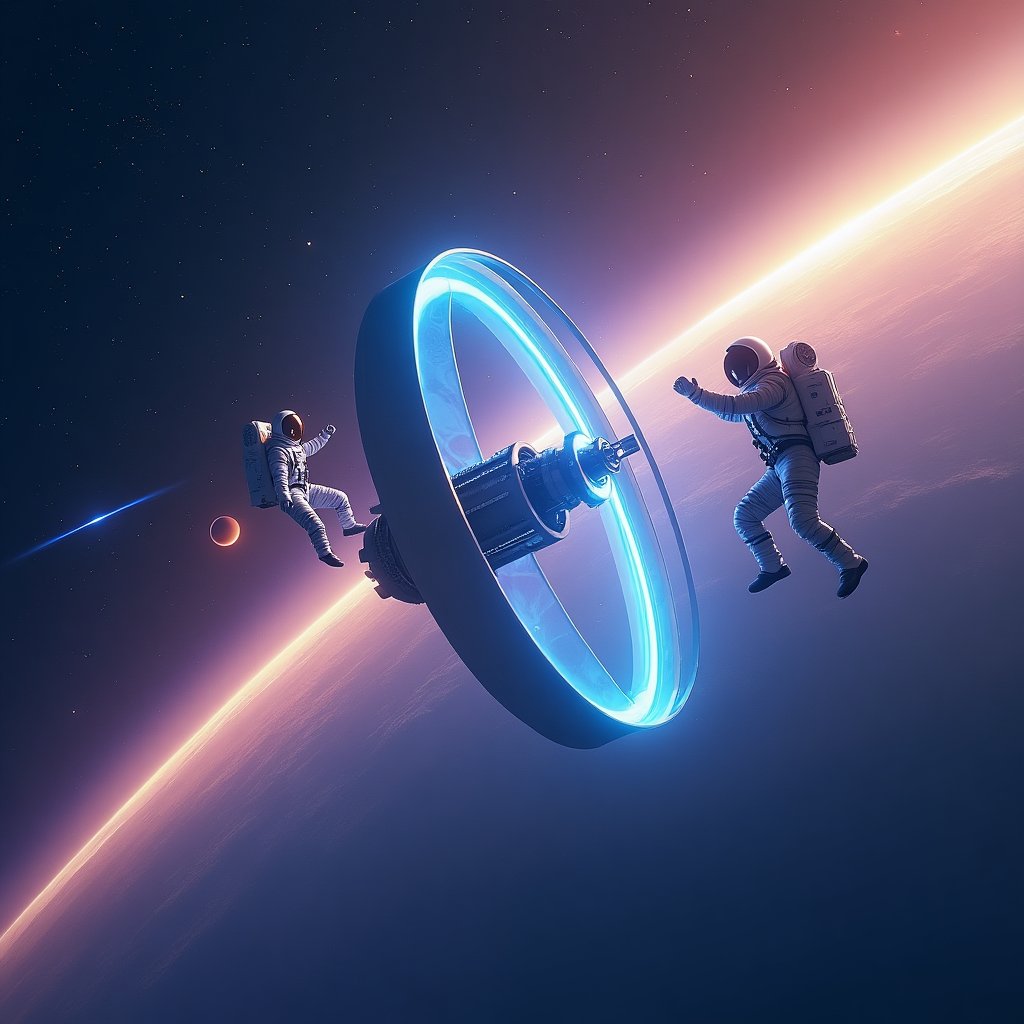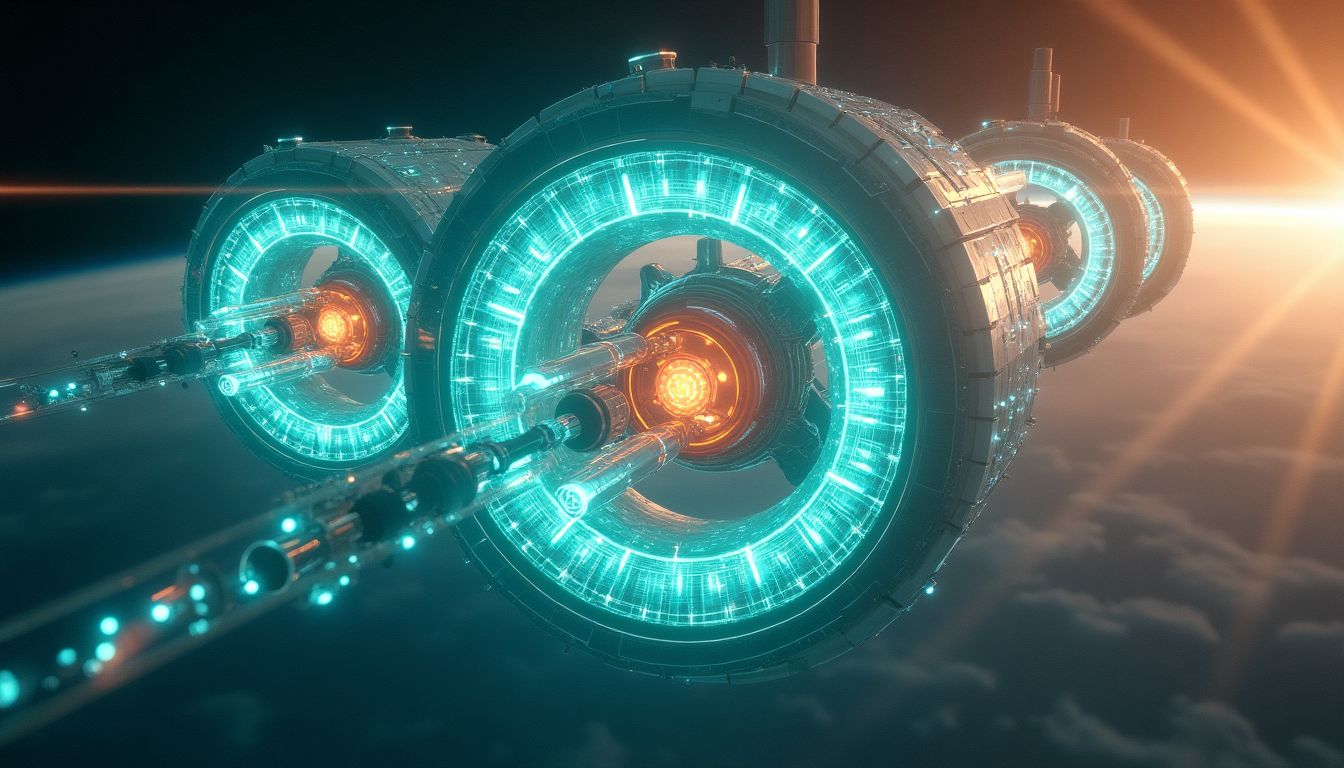Stepping into a space habitat doesn’t have to feel like floating in an endless void. What if you could experience the familiar pull of gravity, just like back on Earth? For decades, the absence of gravity in space has been a thorn in the side of human exploration. Astronauts face muscle atrophy, bone loss, and even psychological stress from prolonged weightlessness. While rotating space stations and centrifugal force have been proposed as solutions, these methods are clunky, energy-hungry, and hardly practical for long-term habitation. Enter Artificial Gravity Generators (AGGs), a concept straight out of sci-fi that could revolutionize space living. But how do we make this dream a reality? The answer lies in Artificial Intelligence (AI).
AI isn’t just for self-driving cars or virtual assistants anymore. It’s becoming the backbone of solving some of humanity’s most complex problems, including how to simulate gravity in space. Visionaries like Elon Musk, who dreams of colonizing Mars, and Stephen Hawking, who pondered the mysteries of the cosmos, have long highlighted the challenges of life beyond Earth. Even Arthur C. Clarke, the mastermind behind "2001: A Space Odyssey," imagined artificial gravity as a cornerstone of space travel. Today, AI is stepping up to turn that vision into reality.
This article dives into the science behind Artificial Gravity Generators and how AI could be the key to making space habitats feel like home. From understanding the physics of gravity to designing cutting-edge technologies, we’ll explore the breakthroughs that could redefine our future in the cosmos.
1. The Science of Artificial Gravity
1.1 Understanding Gravity and Its Effects on Humans
Gravity is more than just the force that keeps us grounded—it’s essential for human health. On Earth, gravity helps maintain muscle mass, bone density, and even the proper circulation of fluids in our bodies. In space, the absence of gravity wreaks havoc. Astronauts can lose up to 20% of their muscle mass in just 11 days of weightlessness, according to NASA. Bone density drops by 1-2% per month, which is a recipe for osteoporosis. Even our eyes and brains aren’t immune. The lack of gravity causes fluid to shift upward, leading to vision problems and headaches.
But it’s not just physical health that’s at risk. Microgravity takes a toll on mental well-being too. Imagine floating in a confined space for months, unable to feel the comforting pull of gravity. It’s no wonder astronauts report feelings of isolation and stress. The longer we stay in space, the more critical it becomes to find a solution to this problem.
1.2 Current Solutions and Their Limitations
So, how do we simulate gravity in space? The most common idea is centrifugal force—think of a spinning space station that creates gravity by throwing things outward. This concept has been around since the days of Wernher von Braun, the rocket scientist who dreamed of wheel-shaped space habitats. But while spinning might sound simple, it’s far from practical.
For starters, creating enough centrifugal force to mimic Earth’s gravity would require a massive structure. And even then, the rotation could cause motion sickness—imagine walking in a spinning wheel while trying to hold your lunch down. Energy consumption is another hurdle. Rotating a space station requires a constant energy source, which is a luxury in the vacuum of space. And let’s not forget the mechanical complexity. More moving parts mean more things that can break. It’s clear that we need a better solution.
1.3 The Need for a Breakthrough
Traditional methods like centrifugal force are Band-Aids, not long-term fixes. As we set our sights on colonizing the moon and Mars, we need something more reliable and scalable. That’s where Artificial Gravity Generators come in. But designing such a device is no small feat. It requires a deep understanding of physics, materials science, and energy systems. That’s where AI steps in. By leveraging the power of AI, we can tackle these complex challenges head-on and create a system that simulates gravity efficiently and safely.
2. The Role of AI in Complex Problem Solving
2.1 AI in Science and Engineering
Artificial Intelligence isn’t just for recommending your next binge-watch on Netflix or helping you avoid traffic jams. It’s a powerhouse in science and engineering, solving problems humans once thought were impossible. From discovering new drugs to predicting weather patterns, AI is everywhere. In MIT labs, AI is designing materials that could revolutionize construction. Over at NASA, it’s helping us map distant galaxies. If AI were a person, it’d be that overachieving friend who somehow manages to juggle 10 projects at once—and still has time for brunch.
2.2 Why AI is Essential for AGGs
Designing Artificial Gravity Generators (AGGs) is no walk in the park. It’s more like trying to solve a Rubik’s Cube blindfolded—while juggling flaming torches. Enter AI. With its knack for crunching data and spotting patterns, AI can tackle the complexity of AGG design head-on. Think of it as the ultimate multitasker: simulating gravity, optimizing energy use, and ensuring safety—all in one go. Without AI, we’d be stuck in the dark ages of spinning space stations and impractical solutions. AI is the flashlight guiding us toward a brighter, gravity-filled future.
2.3 Case Studies: AI in Space Exploration
AI has already proven its mettle in space. Take SpaceX, for example. Their rockets use AI to land themselves back on Earth—like a high-tech boomerang. Meanwhile, NASA’s Mars rovers rely on AI to navigate the Red Planet’s rocky terrain. Even the International Space Station uses AI to monitor systems and keep astronauts safe. If AI can handle Mars and rocket landings, designing AGGs is just the next big challenge on its to-do list.
3. Designing Artificial Gravity Generators with AI
3.1 Core Principles of AGG Design
When it comes to AGGs, we’re not talking about slapping a “Gravity Here” sign on a wall and calling it a day. The core principles involve manipulating gravitational fields, exploring exotic matter, and maybe even dipping into warp drive concepts. Yes, it sounds like Star Trek territory, but that’s where AI shines. It can help us explore these futuristic ideas without requiring a warp-capable starship. The goal? Create a system that’s energy-efficient, scalable, and safe—basically, the Goldilocks of gravity solutions.
3.2 AI-Driven Simulation and Modeling
Before we build AGGs, we need to test them. But who has a spare space station lying around? That’s where AI-driven simulations come in. Imagine a virtual playground where AI can experiment with AGG designs, tweak variables, and see what works. It’s like SimCity, but instead of building cities, we’re crafting gravity generators. These simulations allow for iterative design, meaning we can refine prototypes until they’re just right. And if something goes wrong? No problem—it’s all happening in a computer, not in outer space.
3.3 Materials and Energy Requirements
AGGs aren’t just about fancy physics—they need the right materials and energy sources. This is another area where AI flexes its muscles. By analyzing data on material behavior and energy consumption, AI can predict which materials will hold up under extreme conditions. Think of it as a matchmaker, pairing AGGs with the perfect materials for a long and happy relationship. And let’s not forget energy efficiency. AI can help design systems that use less power, making AGGs a viable option for long-term space missions.
4. Overcoming Challenges and Ethical Considerations
4.1 Technical Challenges
Creating Artificial Gravity Generators (AGGs) is no small feat. One of the biggest hurdles is energy consumption. Simulating gravity requires a massive amount of energy, and in space, where resources are limited, this poses a significant problem. AI can help optimize energy use, but we still need breakthroughs in energy storage and generation, like advanced nuclear reactors or solar power systems.
Another challenge is ensuring reliability and safety. Space is a harsh environment with extreme temperatures, radiation, and micro-meteoroids. AGGs must be durable enough to withstand these conditions while keeping astronauts safe. AI-driven simulations can test these systems in virtual environments, but real-world testing will be essential to prove their reliability.
- Energy Consumption: Finding sustainable energy sources for AGGs is critical.
- Durability: Materials must withstand extreme space conditions.
- Safety: Systems must protect astronauts from mechanical failures or malfunctions.
4.2 Ethical Implications
As with any groundbreaking technology, AGGs come with ethical considerations. Who gets access to this technology? Space exploration has historically been dominated by a few wealthy nations and private companies like SpaceX and NASA. If AGGs become a reality, it’s crucial to ensure equitable access so that all nations and communities can benefit from advancements in space technology.
Another concern is the role of AI in controlling these systems. While AI can optimize and manage AGGs, how much autonomy should it have? Balancing AI decision-making with human oversight is essential to avoid unintended consequences. For example, an AI system might prioritize energy efficiency over safety, leading to potential risks for astronauts.
- Equity: Ensuring fair access to AGG technology for all nations.
- AI Autonomy: Balancing AI’s role with human control to ensure safety.
- Transparency: Making AI decision-making processes clear and understandable.
4.3 Global Collaboration
Developing AGGs isn’t a task for one country or organization. It requires global collaboration. International agencies like the European Space Agency (ESA) and private companies like Blue Origin must work together to pool resources, share knowledge, and accelerate progress. AI can play a key role here by facilitating data sharing and collaboration across borders.
For instance, AI-powered platforms can connect researchers from different countries, allowing them to collaborate on simulations, experiments, and designs. This kind of global teamwork could significantly speed up the development of AGGs, making space habitation a reality sooner than we think.
- Shared Resources: Combining expertise and funding from multiple nations and organizations.
- Collaboration Tools: Using AI platforms to connect researchers worldwide.
- Accelerated Progress: Pooling knowledge to overcome technical and ethical challenges.
5. The Future of Space Habitats with AGGs
5.1 Applications in Space Exploration
Artificial Gravity Generators could revolutionize space exploration. For long-term missions to Mars and beyond, AGGs would help astronauts maintain their health and well-being, reducing the risks of muscle atrophy, bone loss, and psychological stress. This makes extended space travel more feasible and sustainable.
AGG technology could also open the door to space tourism. Companies like Virgin Galactic and Blue Origin are already working on making space travel accessible to the public. With AGGs, space hotels could offer Earth-like comfort, making the experience more appealing to tourists. Imagine floating in a zero-gravity pool one moment and enjoying a meal in a gravity-enhanced dining room the next!
- Mars Missions: AGGs could make long-term habitation on Mars a reality.
- Space Tourism: Enhancing the comfort of commercial space travel.
- Research: Enabling longer and more productive scientific missions in space.
5.2 Impact on Human Life in Space
Living in space doesn’t have to feel like surviving. With AGGs, space habitats could become more “home-like,” improving the quality of life for astronauts. Simple activities like walking, exercising, and even sleeping would feel more natural, reducing the physical and mental toll of space living.
This could have a profound impact on the future of space colonization. If we’re serious about establishing permanent settlements on the Moon, Mars, or beyond, AGGs will be a crucial part of making those habitats livable. They could turn space stations from cramped, sterile environments into vibrant communities where people can thrive.
- Health: Reducing muscle and bone loss in microgravity.
- Comfort: Making daily activities feel more natural.
- Psychological Well-being: Creating a sense of normalcy in space habitats.
5.3 Broader Implications for Science and Society
The development of AGGs isn’t just about space exploration—it’s about pushing the boundaries of science and engineering. Creating artificial gravity could lead to breakthroughs in physics, materials science, and energy systems that have applications far beyond space travel. For example, the materials and technologies developed for AGGs could revolutionize industries like construction, transportation, and renewable energy.
Moreover, AGGs could inspire a new generation of scientists, engineers, and dreamers. Just as the Apollo missions ignited a global fascination with space in the 1960s, the successful development of AGGs could spark a renewed interest in exploring the cosmos. It’s a reminder that humanity’s greatest achievements often come from tackling our biggest challenges.
- Scientific Advancements: Pushing the limits of physics and engineering.
- Inspiration: Motivating future generations to explore space.
- Societal Impact: Transforming industries and improving life on Earth.
6. AI Solutions: How Would AI Tackle This Issue?
6.1 Problem Analysis and Goal Setting
Identify the core challenge: Simulating Earth-like gravity in space. Define success criteria: Energy efficiency, scalability, and human safety. Establish clear metrics for evaluation, ensuring the AGG system can be seamlessly integrated into existing space infrastructure. AI will play a pivotal role in analyzing the feasibility of various approaches, from gravitational field manipulation to exotic matter utilization, ensuring that the chosen path aligns with both scientific and practical needs.
6.2 Data Collection and Modeling
Gather data on gravitational physics, materials science, and energy systems. Utilize AI to create multi-dimensional models of potential AGG designs, incorporating variables such as material durability, energy requirements, and gravitational field stability. Collaborate with institutions like NASA and SpaceX to access real-world data from space missions, enhancing the accuracy of AI-driven simulations.
6.3 Iterative Design and Optimization
Use machine learning algorithms to test and refine AGG prototypes. AI will analyze each iteration, identifying strengths and weaknesses in the design. Focus on optimizing energy efficiency, structural integrity, and user comfort. Leverage AI’s ability to process vast datasets to explore innovative materials and energy sources, such as quantum computing-enhanced energy solutions or metamaterials that can mimic gravitational effects.
6.4 Simulation and Testing
Deploy AI-driven simulations to test AGGs in virtual space environments. Analyze results and make necessary adjustments, ensuring the system performs reliably under various conditions, from microgravity to high radiation. Collaborate with ESA and JAXA to validate simulations with real-world data from the International Space Station and other space habitats.
6.5 Implementation and Deployment
Integrate AGGs into space habitat designs. Monitor performance and make real-time adjustments using AI, ensuring the system remains efficient and safe over long durations. Engage with commercial partners like Blue Origin and Virgin Galactic to explore opportunities for deploying AGGs in upcoming space tourism ventures.
Actions Schedule/Roadmap
Day 1: Assemble a Multidisciplinary Team
- Recruit experts in AI, physics, materials science, and space engineering. Include representatives from IBM’s AI division, MIT, and Caltech.
Day 2: Define Project Scope and Objectives
- Establish clear goals and success criteria for AGG development. Partner with Space Foundation to ensure alignment with global space exploration objectives.
Week 1: Conduct Initial Research and Data Collection
- Gather existing data on gravity, materials, and energy systems. Collaborate with CERN for insights into particle physics and exotic matter.
Week 2: Develop AI Models for AGG Design
- Use AI to create preliminary design models and simulations. Leverage NVIDIA’s GPU technology for high-speed processing.
Month 1: Begin Iterative Design and Testing
- Test prototypes in virtual environments and refine designs. Engage with Lockheed Martin for advanced aerospace testing facilities.
Month 2: Optimize Energy Efficiency and Safety
- Focus on reducing energy consumption and ensuring human safety. Partner with Tesla for innovative energy storage solutions.
Year 1: Build and Test First Physical Prototype
- Construct a working AGG prototype and conduct lab tests. Collaborate with NASA Glenn Research Center for specialized testing environments.
Year 1.5: Integrate AGG into Space Habitat Design
- Incorporate AGGs into existing space habitat blueprints. Work with Bigelow Space Operations for modular habitat integration.
Year 2: Launch Pilot Project in Space
- Deploy AGGs in a space habitat and monitor performance. Collaborate with Airbus for launch and deployment logistics, ensuring a successful pilot project.
Rewriting the Future of Space Habitats
Artificial Gravity Generators powered by AI could transform space exploration, making long-term habitation in space not only possible but comfortable and sustainable. By leveraging AI’s capabilities, we can overcome the technical and scientific challenges of simulating gravity, paving the way for a future where space habitats feel like home. As we stand on the brink of this technological revolution, the possibilities for humanity’s journey into the cosmos are limitless. Imagine a future where families can live, work, and thrive in space, free from the health risks of microgravity. Imagine a future where space tourism becomes as common as air travel, opening up the stars to all of humanity. The journey from Earth to the stars is no longer a distant dream but a tangible reality, powered by the ingenuity of AI and the pioneering spirit of human exploration. What will we discover as we venture further into the cosmos? How will this new frontier shape our understanding of ourselves and our place in the universe? The answers lie ahead, waiting to be uncovered.
FAQ
Q1: What is an Artificial Gravity Generator (AGG)?
An Artificial Gravity Generator (AGG) is a system designed to simulate Earth-like gravity in space. This helps astronauts avoid the health risks of living in microgravity, like muscle loss and bone density problems. Think of it as a way to bring the comfort of Earth’s gravity to space habitats.
Q2: How does AI contribute to AGG development?
AI is a game-changer for AGGs. It helps scientists design, test, and improve these systems by processing massive amounts of data and finding the best solutions. For example, AI can simulate how gravity would work in space and suggest ways to make AGGs more energy-efficient and safe. NASA and SpaceX are already using AI for space tech, and AGGs could be the next big thing.
Q3: Are AGGs currently in use?
Not yet. AGGs are still in the research and development phase. Scientists and engineers are working hard to make them a reality, and AI advancements are speeding up the process. It’s like baking a cake—you need the right ingredients and time to get it just right.
Q4: What are the main challenges of creating AGGs?
Creating AGGs isn’t easy. Some of the biggest challenges include:
- Energy Consumption: AGGs need a lot of power to work efficiently.
- Safety: They must be safe for humans to use in space environments.
- Scalability: Making AGGs work for large space habitats is tricky.
AI is helping tackle these problems by testing different designs and finding the best solutions.
Q5: How long until AGGs become a reality?
With the help of AI, AGGs could become a reality in the next 10 to 15 years. Organizations like ESA and NASA’s JPL are already working on similar technologies. It’s like building a bridge—you need time, resources, and teamwork to make it happen.
Wait! There's more...check out our gripping short story that continues the journey: A Weight That Can’t Be Measured
Disclaimer: This article may contain affiliate links. If you click on these links and make a purchase, we may receive a commission at no additional cost to you. Our recommendations and reviews are always independent and objective, aiming to provide you with the best information and resources.
Get Exclusive Stories, Photos, Art & Offers - Subscribe Today!





























1 comment